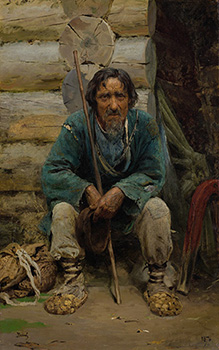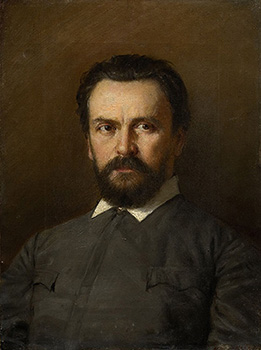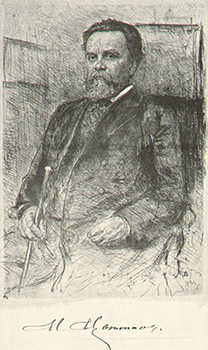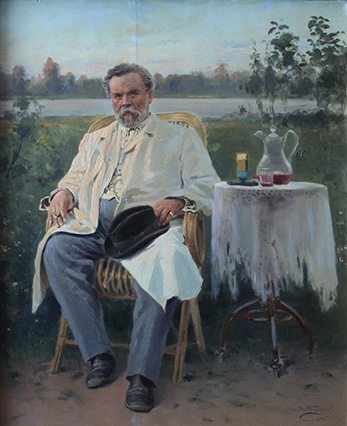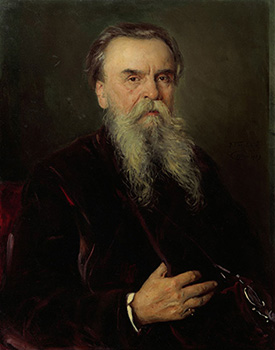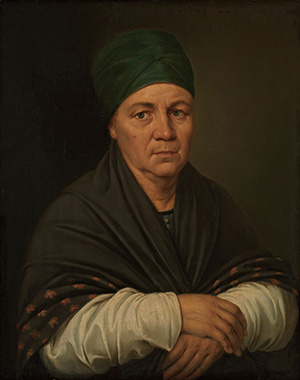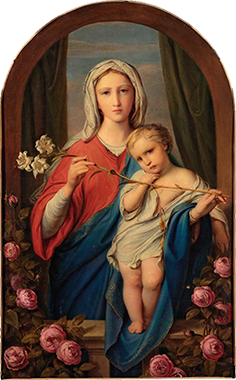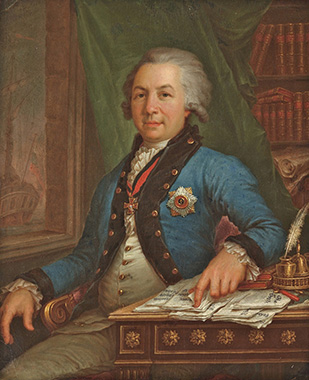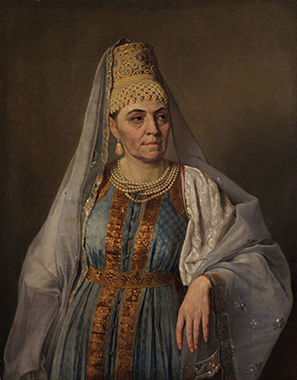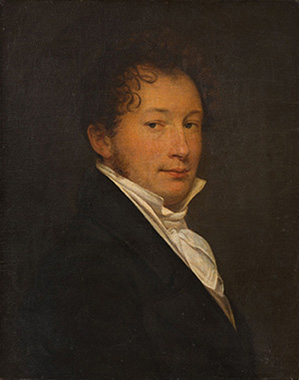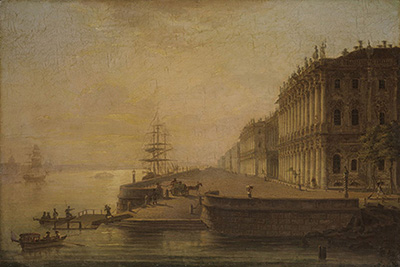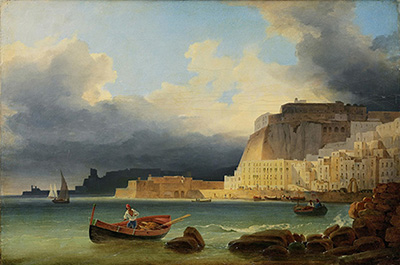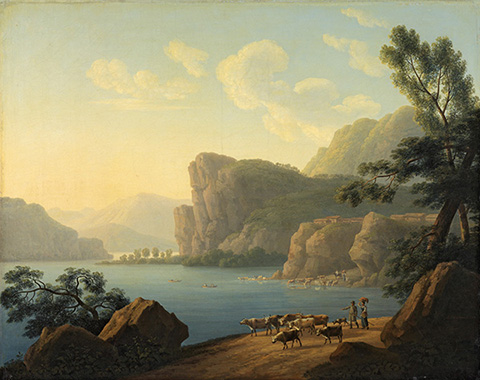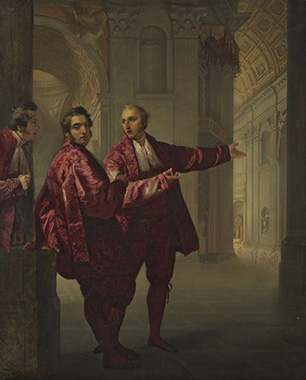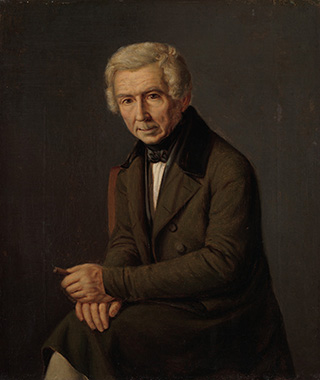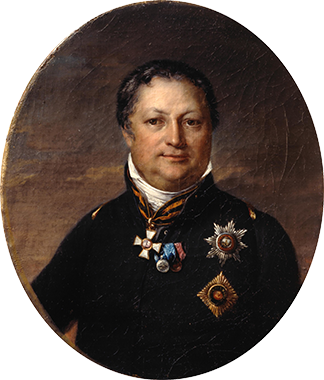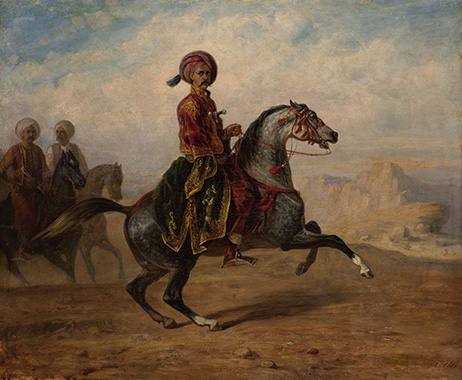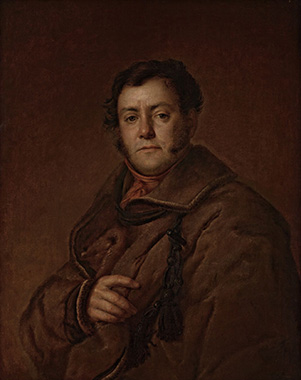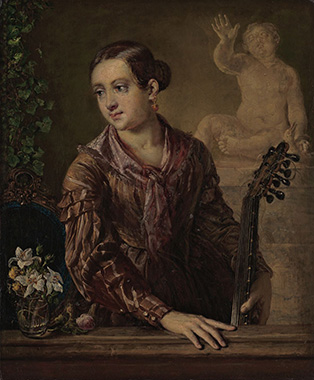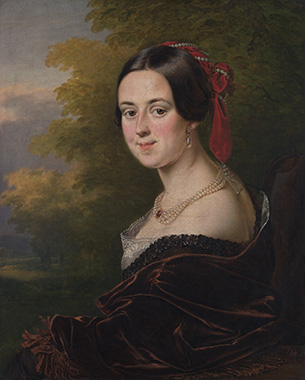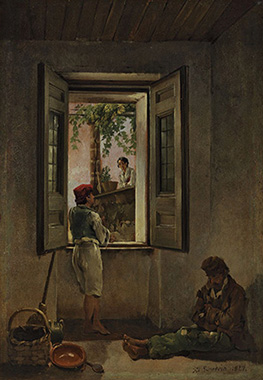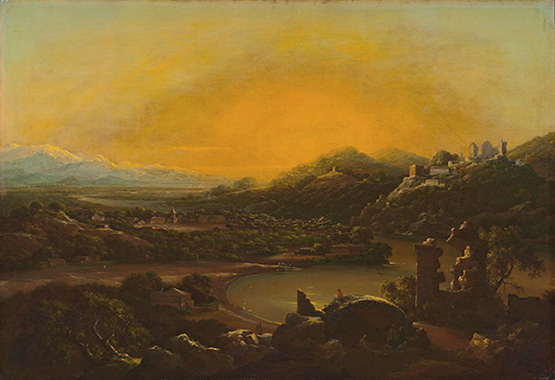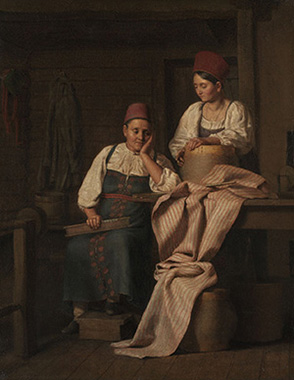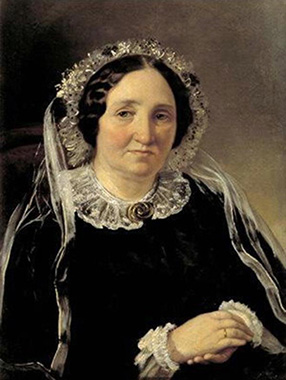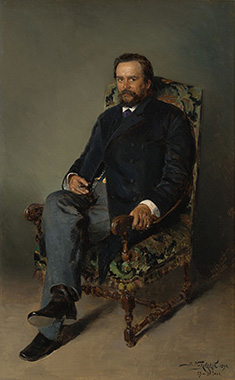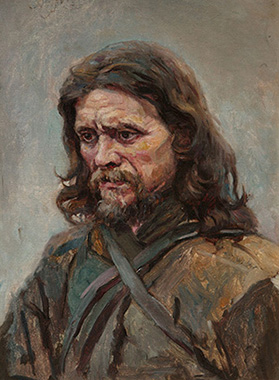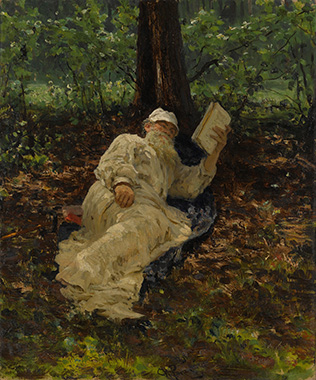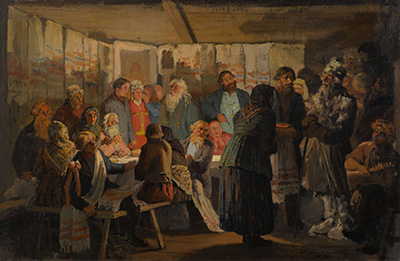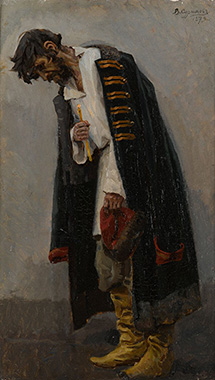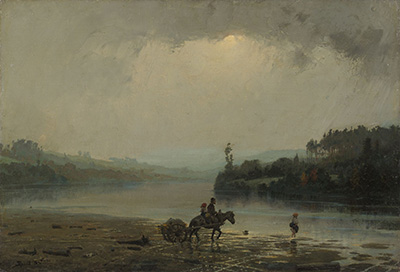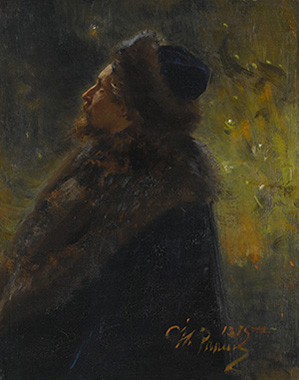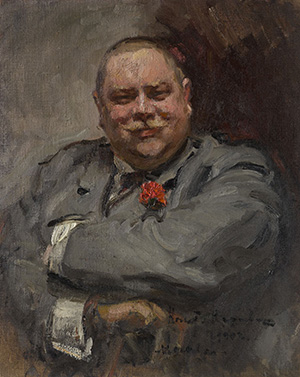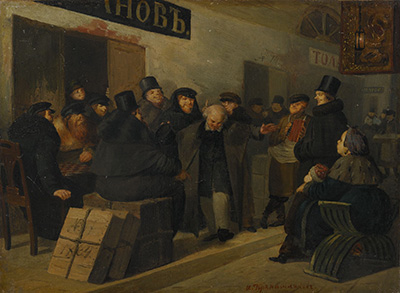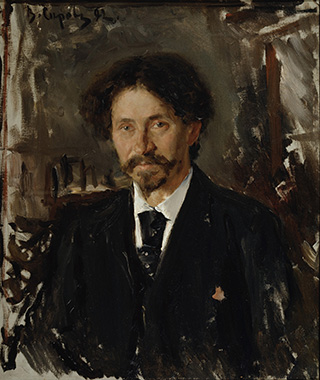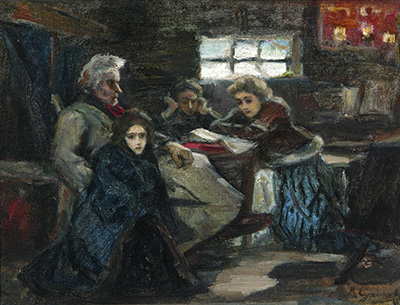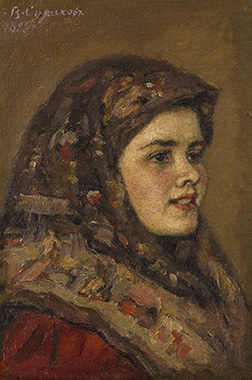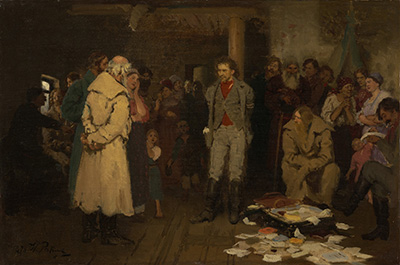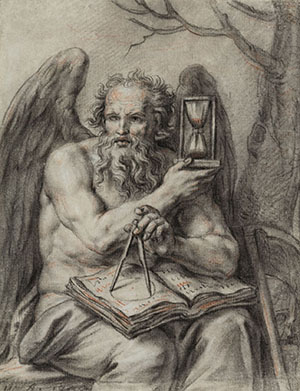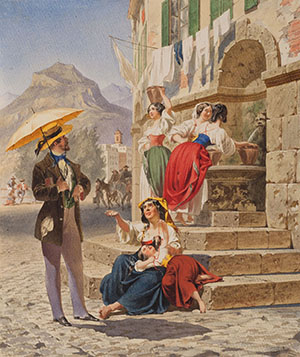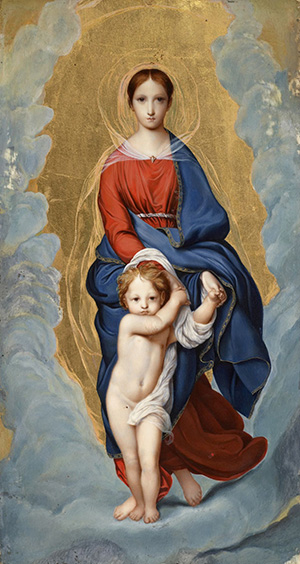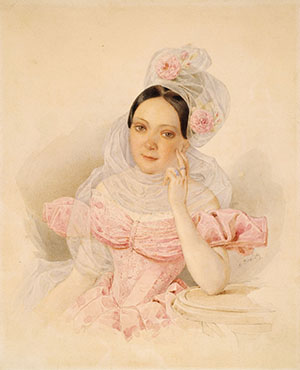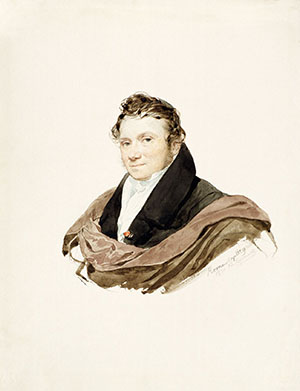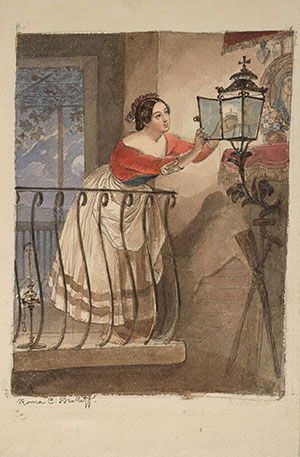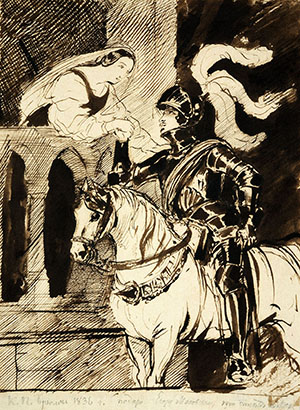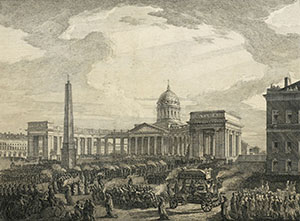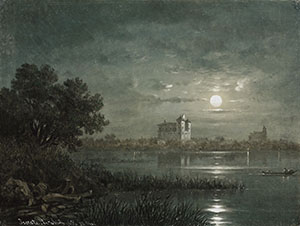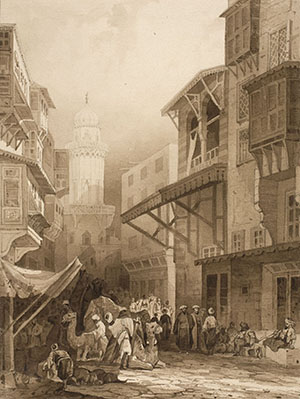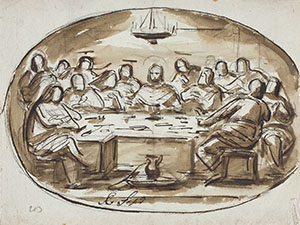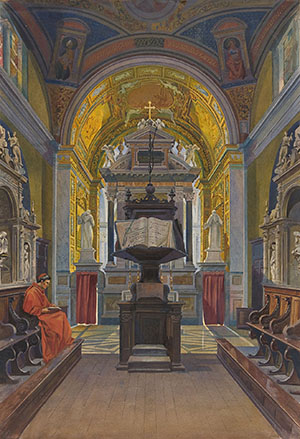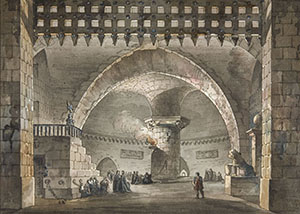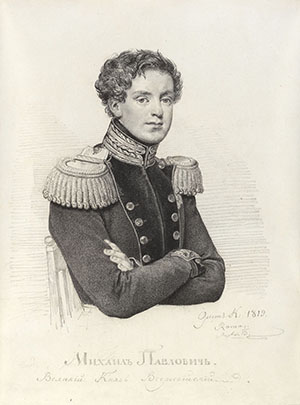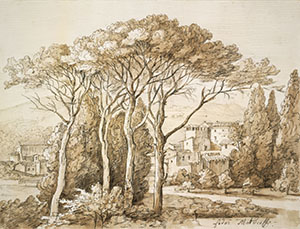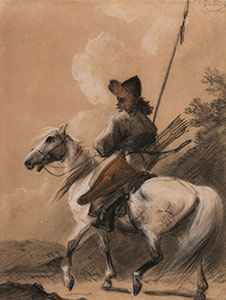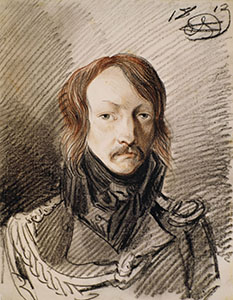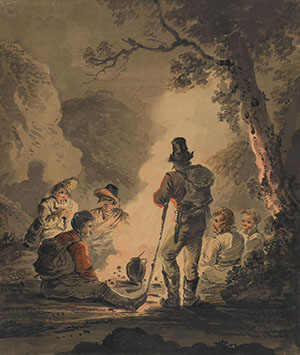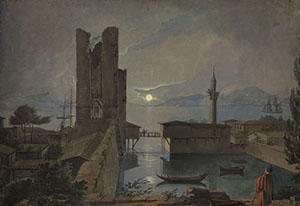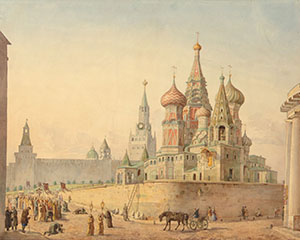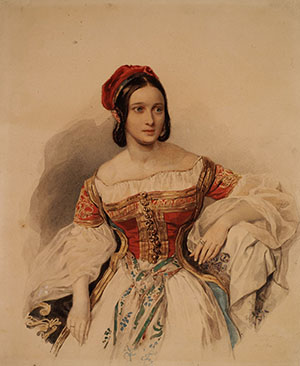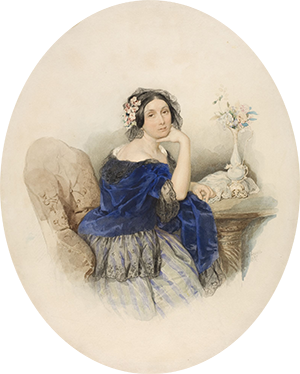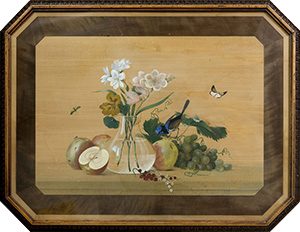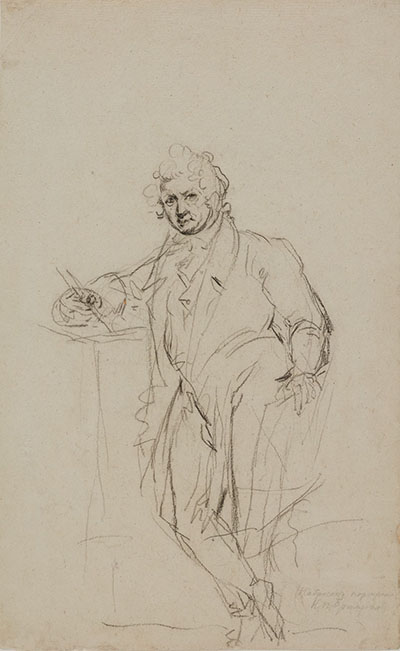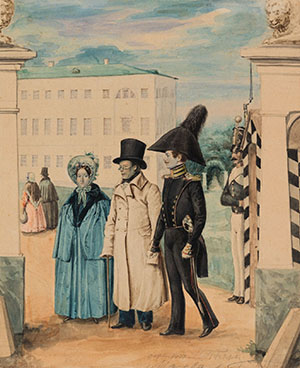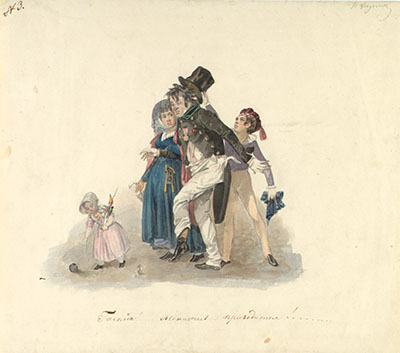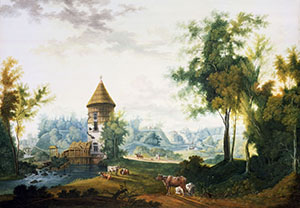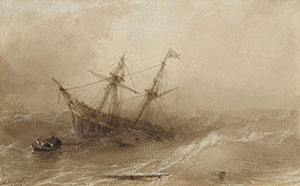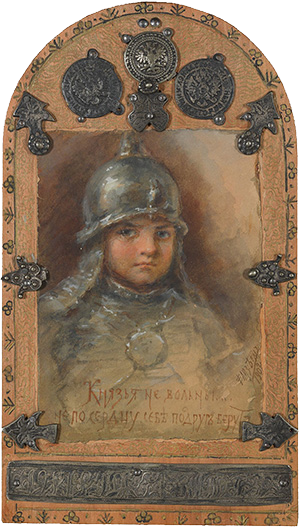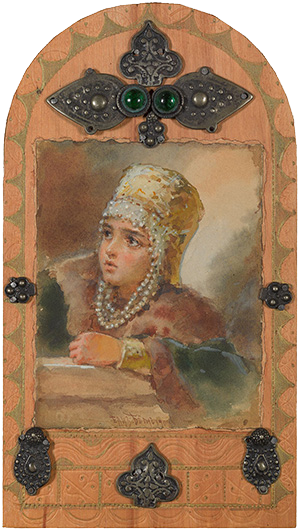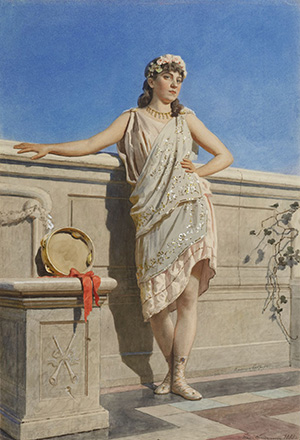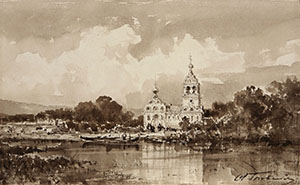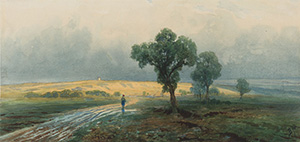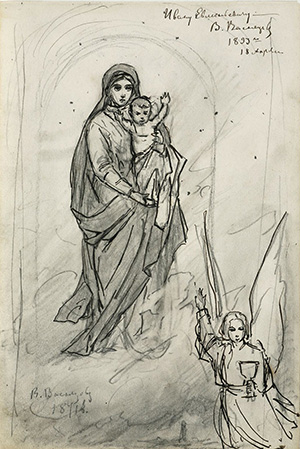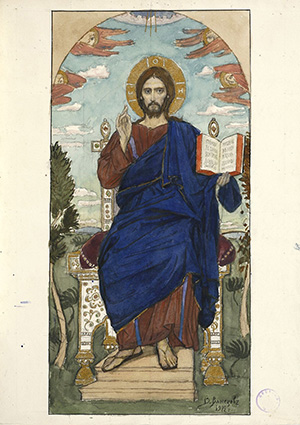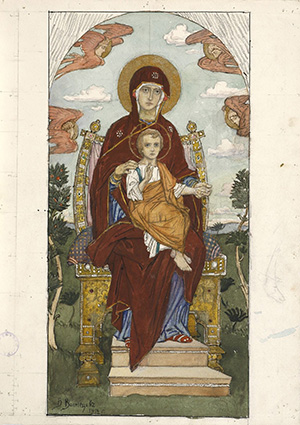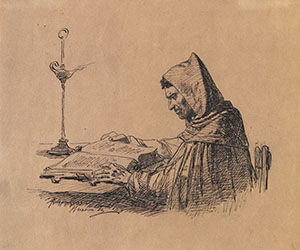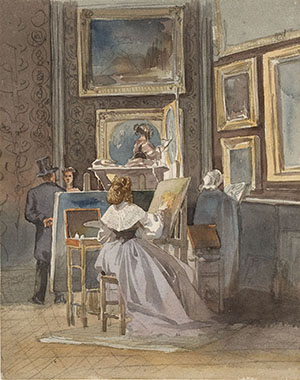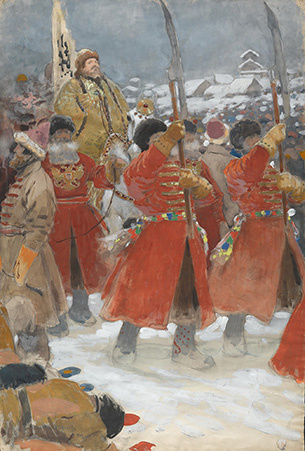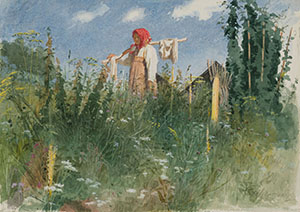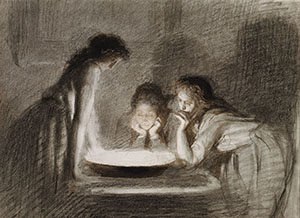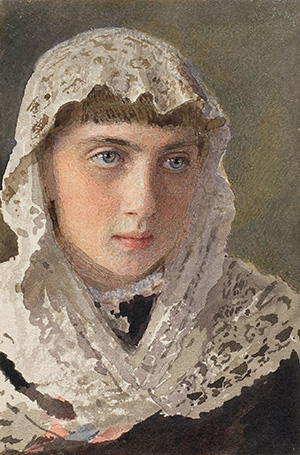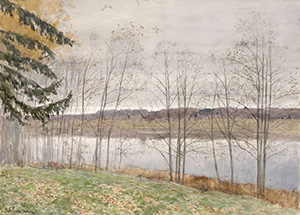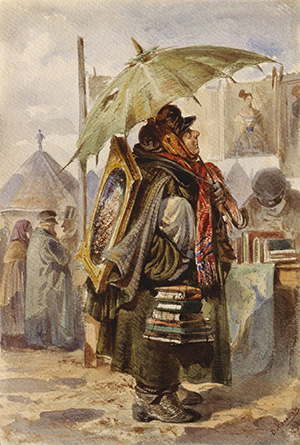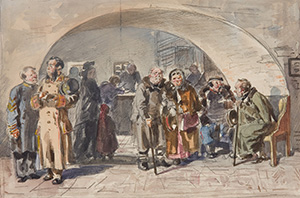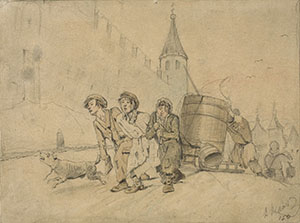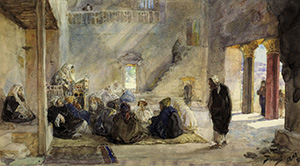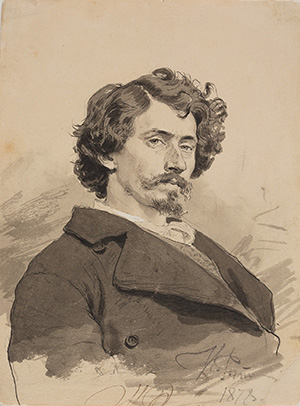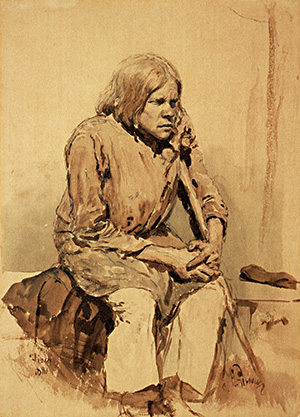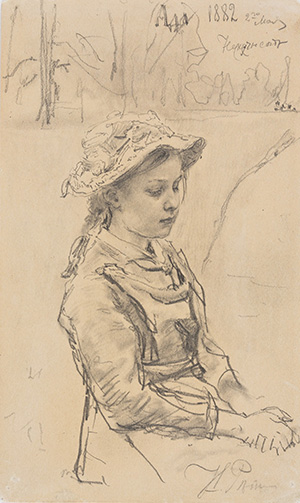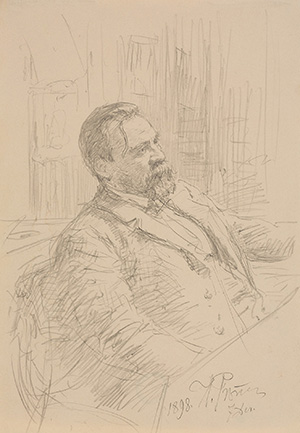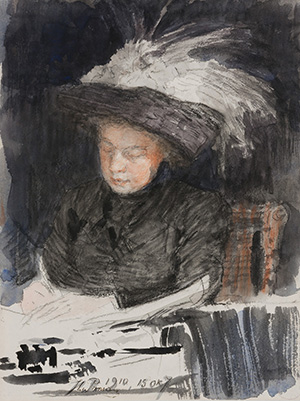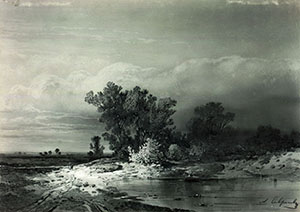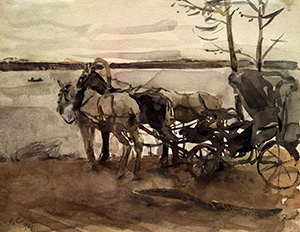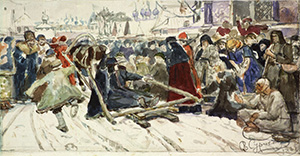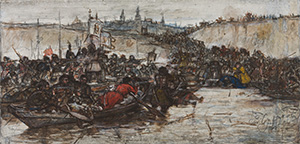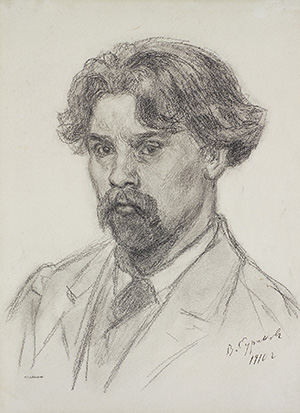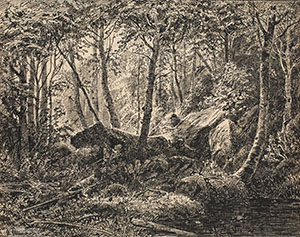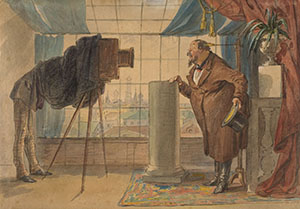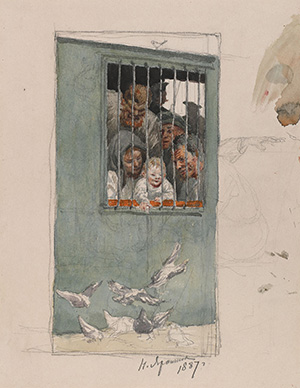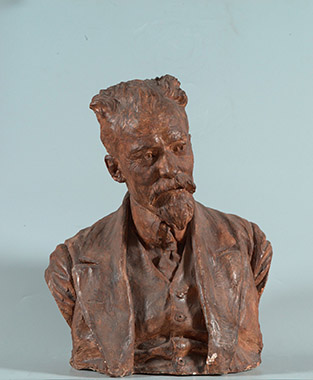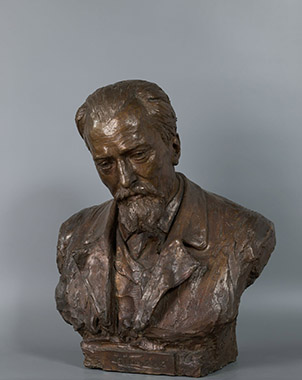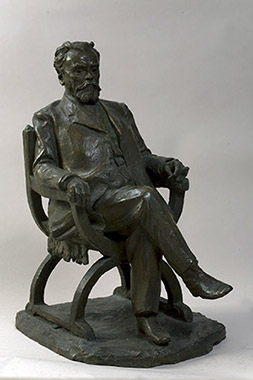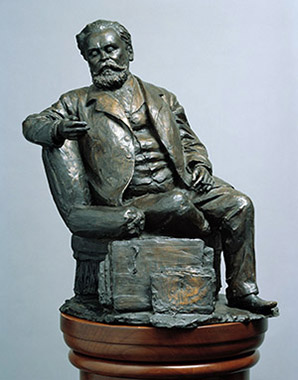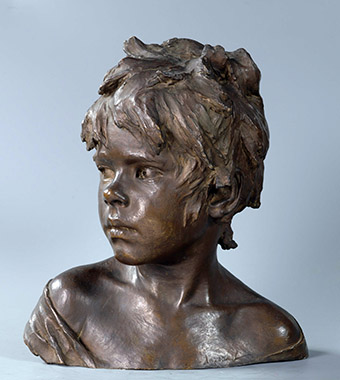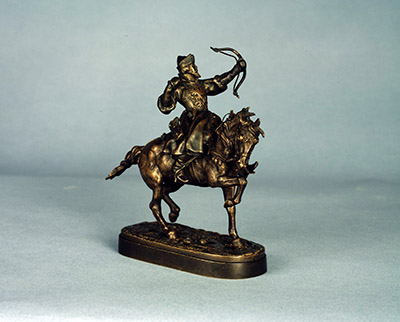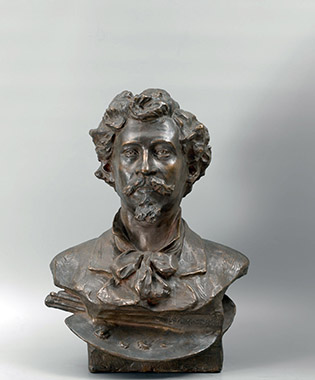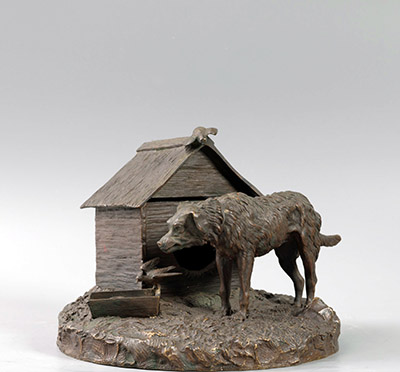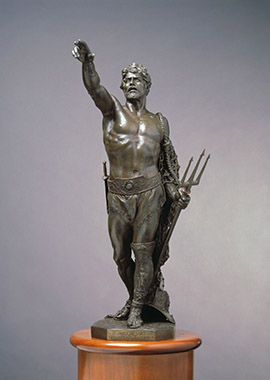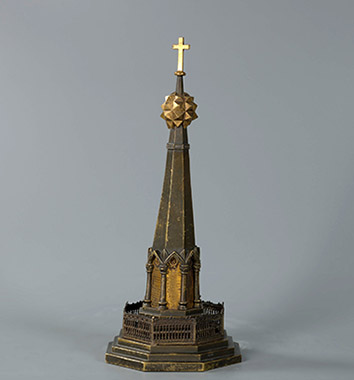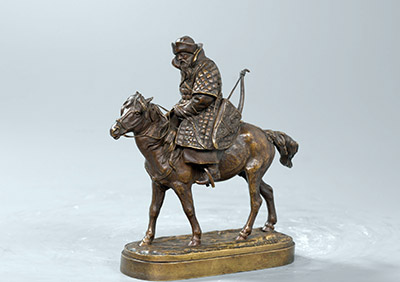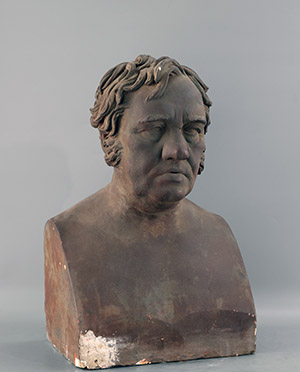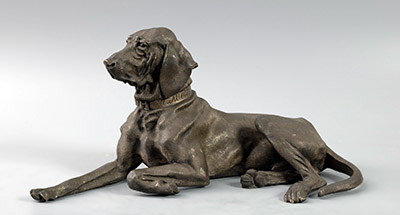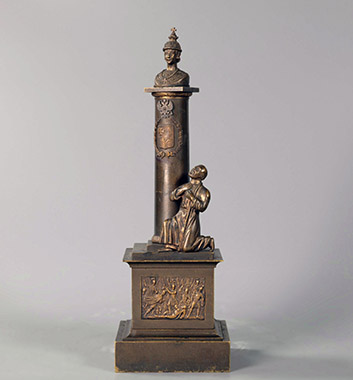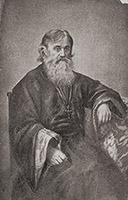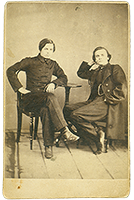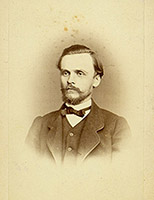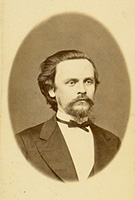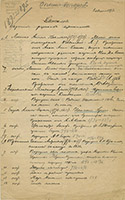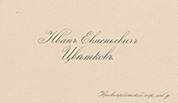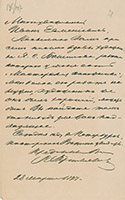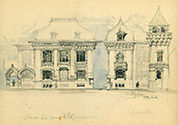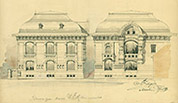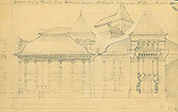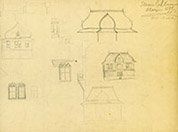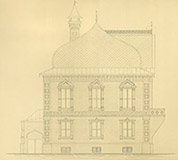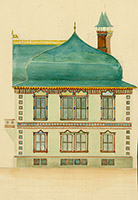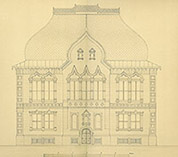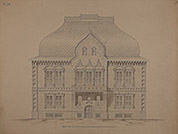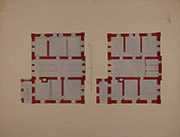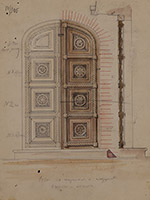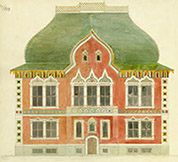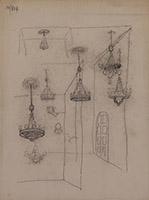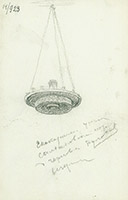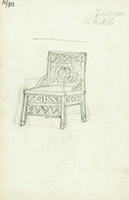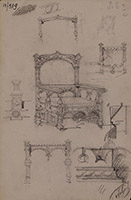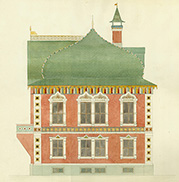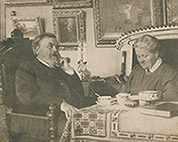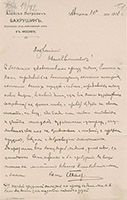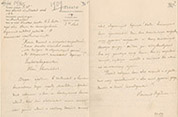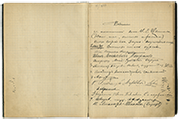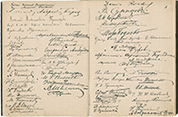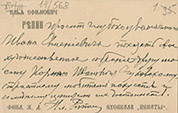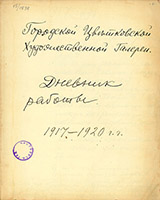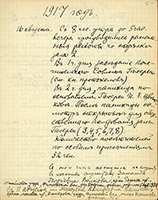Ivan Tsvetkov and His Gallery
In April 2020, we celebrate 175 years since the birthday of Ivan Tsvetkov, a famous collector and founder of a private art gallery in Moscow. He was born into a village priest’s family in the Alatyrsky Uyezd of the Simbirsk Governorate. He studied at the Alatyr Religious School and the Simbirsk Gymnasium, and later at the Faculty of Mathematics of the Moscow State University. After graduation, he joined the Moscow Joint-Stock Land Bank as an accountant and worked his way up to become a member of the Assessment Commission of the Bank. Since 1895 to the end of his life, he was the permanent Chair of this Commission.
Tsvetkov started his collection at the turn of the 1870s. He favoured graphic art works and paintings by the Itinerants, who were his contemporaries (I. Kramskoi, I. Shishkin, I. Repin, V. Surikov, and others), as well as works by Russian masters of the 18th and early 19th centuries (V. Borovikovsky, A. Venetsianov, K. Bryullov, O. Kiprensky). He was passionate about collecting genre paintings, landscapes, views of old Moscow and other Russian cities, and self-portraits of artists. Approximately 2000 items produced by Russian artists - graphic art works, paintings, sculptures – made Tsvetkov’s collection. According to A. Bakushinsky, I. Tsvetkov “became an owner of the richest collection – in Moscow, and maybe in all of Russia – of drawings by Russian masters, covering an approximately 150-year period of the development of this art.” The establishment of the Tsvetkov Gallery was a newsworthy event in the art scene of Moscow.
Tsvetkov’s collection was housed in a Russian Revival style mansion located at Prechistenskaya Embankment, which had two floors and was built in 1898-1901 in accordance with sketches and instructions by V. Vsnetsov. The mansion has stood the test of time: today it is the French Military Attaché’s residence. The Tsvetkov Gallery was functioning as a public museum since its owner donated it to the City of Moscow in 1909. After its closure in 1926, the entire graphic art collection, about a hundred paintings, and the collector’s archive were moved to the Tretyakov Gallery. Over three hundred pictures have been transferred to the State Museum Fund and then distributed to regional museums and museums of the former Republics of the USSR. A considerable part of the archive has been taken to the Russian State Archive of Literature and Arts.
The Ivan Tsvetkov and His Gallery exhibition is especially important with regard to the concept development and design of the Moscow Collector Museum, which will be launched in the Ryabushinsky House in Moscow (3(Tretiy) Golutvinskiy Lane, 8/10 build. 1). The display of the Museum will be dedicated to famous Moscow art collectors, and to the history of collecting and collections. The Moscow Collector Museum will join the Small Museums group of the Tretyakov Gallery; its launch is scheduled for 2023-2024.

I.E. Tsvetkov and his collection. Chronicle
1845
April 28
Born in the village of Astradamovka, Alatyr district, Simbirsk governorate, in a poor priestly family.
1862 — 1863
Education at Simbirsk Theological Seminary.
1864 — 1866
Education at Simbirsk Gymnasium.
1868 — 1869
Education at the Department of Mathematics of Kazan University.
1869–1873
Education at the Department of Mathematics of Moscow University, maintaining a thesis on Integration of linear equations with constant coefficients.
1871
Explores the collections of Golitsyn and Rumyantsev museums in Moscow.
1872
Summer
Travels to Geneva with the family of Prince I.A. Gagarin. Visits art galleries in Vienna and Berlin.
1873
Visits the second Itinerant Art Exhibition in Kharkov, which he considered as his first acquaintance with contemporary Russian painting.
1874
January
Works as an accountant in the Moscow Land Bank.
June
Starts visiting Pavel Mikhailovich Tretyakov’s Gallery.
1876
April
Appointed to the position of an agent for assessing property provided to Moscow Land Bank as collateral.
1877
From this year on, Tsvetkov makes annual trips to Saint-Petersburg to admire paintings in the Hermitage and the Kushelev Gallery, to visit the museum of the Academy of Arts and exhibitions of Russian art.
1877
First acquisitions for his collection of paintings.
1881
Acquires the painting Narrator of Russian epic poems Nikita Bogdanov (1876, State Tretyakov Gallery) by Polenov, which will subsequently be considered as the beginning of his collection of Russian painting.
Early 1880s
Becomes a member of Moscow Society of Art Lovers.
1886
Buys a mansion in Krivoarbatsky Lane.
Late 1880s
Gets acquainted with P.M. Tretyakov.
1890
April
Appointed a member of the Bank’s Evaluation Commission.
1892
Acquires just 11 paintings, belonging exclusively to the Russian school. During the 1890s, almost all of European paintings left Tsvetkov’s collection, some of them were exchanged for Russian paintings.
1892 — 1898
Regularly associates with P.M. Tretyakov and I.S. Ostroukhov, exchanging art news and books.
1895
Appointed Chairman of the Evaluation Commission of Moscow Land Bank.
Autumn
Travels abroad with Collector S.S. Shaikevich for studying paintings and drawings by old masters (Vienna, Venice, Rome, etc.).
1899
June 8
Elected for a term of three years as a member of Tretyakov Gallery Council that was formed after the death of its founder and also included I.S. Ostroukhov and V.A. Serov.
Autumn
Buys land at Prechistenskaya embankment.
1900
September
Elected as a trustee of Alexander Smolensk School by the Moscow City Duma.
1901
Displays his collection in the house constructed on Prechistenskaya embankment.
September 27
Elected Chairman of Moscow Society of Art Lovers (until 1905).
1903
Arranges optional drawing and painting classes for students of the 1st residence of Nicholas the 2nd Moscow University, at his own expense. Drawing lessons were taught until 1905.
August 27
At the Council meeting, Tsvetkov presents the first exhibition of icons in Tretyakov Gallery with the participation of N.P. Likhachev, N.P. Kondakov, V.M. Vasnetsov and I.S. Ostroukhov.
October 27
Elected a full member of the Academy of Arts.
1904
Tsvetkov publishes and distributes to his friends, free of charge, the List of paintings and drawings from his collection.
1909
Donates his collection (300 paintings, 1200 drawings) and the house on Prechistenskaya embankment to the city of Moscow. After donating the gallery to the city, he purchases 11 more paintings for it from May to December.
1911
February
The review Russkaya Starina (Russian Antiquity) publishes a biography of Tsvetkov, written by I.I. Yanzhul (the memoirs written by Tsvetkov for Yanzhul were published in 1909).
1915
Publishes the last lifetime inventory of his collection ( The List of Artworks of Tsvetkov’s Gallery), which includes 1819 works.
1917
February, 18
Dies from angina pectoris.
August, 16
The City Duma’s Commission transforms Tsvetkov’s Gallery into an independent museum, open for visiting.
1926
The State Tretyakov Gallery receives the collection of drawings and paintings, Tsvetkov’s personal archive and library. A part of the collection of paintings (over 100 paintings) remained in the Gallery. Over the next few years, more than 300 paintings were transferred to the State Museum Collection and distributed to other museums of Russia.
Virtual Tour around the Tsvetkov Gallery
Tsvetkov’s collection was housed in a two-storey mansion on the Prechistenskaya Embankment, built in the Pseudo-Russian style between 1898 and 1901 after V.M. Vasnetsov’s drawings and instructions (the building has survived). The Tsvetkov Gallery was open to public (by appointment for special groups) as a museum from 1909 — from the moment the owner donated it to the city of Moscow.
The paintings were hung in the halls in chronological order, with the great halls of the first floor housing the paintings by the collector’s contemporaries, while the smaller rooms of the ground floor – the works of an earlier period: the second half of the 18th – the first half of the 19th century. The graphic works were kept in special files, in bookcases, so that the drawings would be hidden from light.
The Tretyakov Gallery’s department of film and photo documents has preserved unique photos of the early 20th century with a view of each hall of the Tsvetkov Gallery, the way it was in the owner’s time.
What is interesting is that the mansion served simultaneously as a gallery and a residential house to its owner, that is why one can see in the photos the living-rooms, study and bedroom. Those photos are used in the virtual tour around the Tsvetkov Gallery, which has been done for the first time and is a unique multimedia exhibition programme.
View of Tsvetkov Gallery from Prechistenskaya Embankment

View of Tsvetkov Gallery from Moskva River

View of Tsvetkov Gallery from Kursovoy (Nizhny Lesnoy) Lane

Entrance hall of Tsvetkov Gallery. On the left, Anna Feodorovna, I. E. Tsvetkov’s wife

– Building in the courtyard of Tsvetkov’s house, from Kursovoy (Nizhny Lesnoy) Lane
Behind, the warehouse for bentwood furniture manufactured in Brothers Tonet’s factory

Painting of the 18th – first half of the 19th century
Tsvetkov’s memoirs mention three ten-year periods of his collecting activities. Between 1881 and 1891, he acquired a relatively modest number of pictures – mainly at occasional sales and at a low price. He was just buying pictures that he liked, with no intention to start a collection. In 1891-1901, he conceived the idea to build a small collection, a sort of painting chrestomathy. For this purpose, he made a collection plan defining the artists that ought have been regarded as the most prominent representatives of their epochs, and which painting genre –the most characteristic one – was to represent each of these artists in his collection. In spring 1901, when he moved to a new house at Prechistenskaya Embankment, Tsvetkov started actively developing his collection and systematising the display of the Gallery.
In Tsvetkov’s collection, paintings of the eighteenth and early nineteenth centuries were significantly outnumbered by graphic art works, but in terms of their quality and prominence of the artists who had created them, the former were in no way inferior to the latter. These paintings included portraits by A. Antropov, V. Borovikovsky, G. Ugryumov, K. Bryullov, O. Kiprensky, A. Varnek, S. Zaryanko; landscapes by S. Shchedrin, A. Martynov, Maxim and Sokrat Vorobyov, K. Rabus, A. Mordvinov, brothers Grigory and Nikanor Chernetsov, and even a sketch by A. Ivanov. The collection was particularly rich with genre portraits by V. Tropinin (20) and A. Venetsianov (18), often showing people dressed in folk costumes (Tropinin’s Portrait of Simbirsk Merchant V. Yakovlev, Khokhol, and Khokhlushka; Venetsianov’s Countrywoman in Blue Sarafan, Wet Nurse and Baby, and Portrait of the Artist’s Wife Marfa Afanasyevna in Russian Costume). Apparently, this passion of Tsvetkov to folk types and national costumes was related to the fact that he was from the grassroots of the society and had a patriarchal upbringing.
In addition to the portraits and landscapes, the collection included genre paintings (Infant Baptism by I. Tupylev, To the Hunt by Ye. Krendovsky, Old Soldier’s Story by L. Plakhov), paintings based on religious motifs (A. Yegorov’s Joseph and Potiphar's Wife and Angel Appearing to Shepherds; F. Bruni’s Madonna and Child with Roses and Holy Great Martyr Alexandra). Allegorical (Satyr and Bacchantes by M. Scotti, Awakening of Graces by F. Bruni) and historical (Death of Alcibiades by Ya. Kapkov) paintings are less usual for this collection, while still lifes are not present at all (although works by I. Khrutsky and F. Toropov might have been of interest to the collector).
Along with paintings by famous masters, Tsvetkov acquired works by unrenowned artists, such as Peasant Family before Dinner by F. Solntsev.
Following his taste and passions, his level of education in arts, and the opportunities in his life, I. Tsvetkov, like P. Tretyakov and I. Ostroukhov, established a museum of Russian panting and graphic arts, which was a great contribution to the Russian culture studies.
N. Presnova
Painting of the second half of the 19th – early 20th century
Tsvetkov’s taste in collecting Russian art was influenced by his visits to the Tretyakov Gallery (started in 1874), the Society for Travelling Art Exhibitions, and the Moscow Society of Art Lovers.
In 1881-1891, along with works by old European and Russian masters, Tsvetkov acquired paintings by V. Vereshchagin, A. Kiselyov, I. Levitan, F. Vasilyev, and others. Later, only a few things acquired in the 1880s remained among Tsvetkov’s possessions (including such canvases as Bylina Teller Nikita Bogdanov by V. Polenov, Satyrs in Happy Arcadia by V. Khudyakov, and Landlord Congratulating the Newlyweds by G. Myasoyedov). Since the end of the 1880s, he started adding to his collection works by V. Makovsky, N. Nevrev, V. Surikov, and I. Pryanishnikov. These artists were his friends, and his interest to their art did not cease in the following years.
By the agency of V. Makovsky, Tsvetkov got acquainted with P. Tratyakov at the end of the 1880s. In the 1890s, the collector was developing his network with Moscow and St. Petersburg artists, and building a gold reserve of works by the Itinerants, who were favoured by Tretyakov (V. Perov, I. Shishkin, I. Kramskoi, F. Vasilyev, K. Huhn, V. Maksimov, and others); his collecting activities were gradually becoming goal-directed.
Unlike Tretyakov, Tsvetkov did not seek to acquire many works produced by a selected artist. His stated principle of a representative collection (“My humble collection will be a brief summary, using which one will be able to easily trace almost all history of the Russian painting art development”) had its exceptions. In the Tsvetkov Gallery, paintings by V. Makovsky (22) and I. Repin (19) were in the majority.
Tsvetkov was close with the early Itinerants and purchased works by K. Lemokh; A. Korzukhin; A. Litovchenko,; N. Shustov; K. Makovsky; students of I. Pryanishnikov (A. Korin and V. Komarov – Tsvetkov posed for them to make his portraits) and of V. Makovsky (V. Kuznetsov and N. Bogdanov-Belsky); friends of Makovsky (I. Tvorozhnikov) and K. Savitsky (N. Grandkovsky); and others. At the Moscow Society of Art Lovers drawing evenings, Tsvetkov demonstrated a particularly strong interest in the artists who were working there, and sought to discover individuality in each of them.
A distinctive feature of Tsvetkov’s collection was a substantial number of studies and sketches by contemporary artists – they were appropriately sized for the collector’s relatively small house. The collection included early studies for such paintings as Surikov’s Boyarynya Morozova, Maksimov’s Sorcerer Сomes to a Peasant Wedding, etc., as well as sketches for paintings that had been planned but never actually painted. Tsvetkov was also interested in paintings produced by artists as copies of their own original works. Sometimes the collector even commissioned them personally (Dark People, a painting dated 1874 and finished by Savitsky in 1893, and his canvas Paying Their Respects to the Icon).
Due to the house built at Prechistenskaya Embankment (1901), Tsvetkov was able to purchase a number of large paintings, including official and semi-official portraits. In the middle of the 1900s, a gallery of images of painters, singers, performing artists, scientists, and writers started to emerge within Tsvetkov’s collection. In the 1900s, Tsvetkov was increasing the number of contemporary paintings in his collection. Doing his best to keep up with trends, he bought works by K. Yuon, K. Korovin, V. Serov, and M. Nesterov.
E. Yevseyeva
The Tsvetkov Gallery Collection of Drawings
Graphic art works by Russian masters and foreigners who worked in Russia make the biggest and the most precious part of the comprehensive art collection of Ivan Tsvetkov. It is worth mentioning that it was a graphic art work which marked the beginning of the collection. Tsvetkov called the first drawing that he acquired at an ironmonger's shop at the Arbat in 1875 – I. Akimov’s Saturn – the cornerstone of his entire collection.
Tsvetkov started collecting drawings during the opportune period when other collectors, including P. Tretyakov, had little interest in them. Years later, he reminisced that he “had a good idea to start collecting drawings . . . produced by Russian artists.” Due to his enthusiasm and dedication to his dream, after more than thirty years, Tsvetkov became an owner of a very rich collection. It embraced an extremely diverse range of interesting works made with the application of different techniques during the period from the 18th to the early 20th century. These oeuvres included studies, sketches, drafts of paintings, and independent pieces in all genres: landscapes, portraits, works based on historical and mythological motifs, genre scenes, allegories, and still lifes. The best among them were pencil and pen drawings, watercolours, gouaches, and pastels by F. Matveyev, A. Orłowski, G. Quarenghi, K. Bryullov, P. Fedotov, M. Vorobyov, P. Sokolov, V. Tropinin, A. Savrasov, V. Perov, V. Makovsky, I. Repin, V. Surikov, V. Polenov, V. Vasnetsov, I. Levitan, V. Serov, and any many others.
In 1925, this collection with almost 1500 items became a basis for the graphic art reserve of the Tretyakov Gallery. The drawings, which Ivan Tsvetkov loved so deeply, are systematically exhibited – they continue bringing joy to everyone who is passionate about this visual art type.
M. Krylova
Sculpture in the Tsvetkov Gallery
By 1915, the year when its Catalogue was published, 38 sculptures had been added to Tsvetkov’s collection. During the Tsvetkov Gallery closure in 1927, all of them were transferred to the Tretyakov Gallery. Two years later, after the order of the RSFSR People's Commissariat for Education to redistribute the collection, fourteen works, rather diverse in terms of impressiveness and technique, remained at the Tretyakov Gallery.
Tsvetkov’s sculpture collection was heterogeneous. He acquired works that were both usable and ornamental: vases, clocks, candle holders, inkpots, and statuettes. He preferred to buy bronze statuettes by the famous sculptor of the second half of the 19th century E. Lanceray. Tsvetkov’s collection had 12 works by this master, including two figurines Tsar’s Hunter of the 16th Century (1870s, Tretyakov Gallery) and Courier from the Epoch of Ivan the Terrible (1870s, Tretyakov Gallery) cast at the F. Shopen Foundry. It is possible that Lanceray himself participated in the casting process. The sculptor made the Courier from the Epoch of Ivan the Terrible when he was working on models portraying characters from the Prince Serebrenni novel by A. Tolstoy, keeping in his mind the Courier of the 16th Century painting by the famous painter V. Schwarz (1868, Tretyakov Gallery). Tsvetkov considered a desk set by Lanceray (late 1870s, bronze, Dagestan Museum of Fine Arts) to be a gem of his collection. The following statuettes can be regarded as illustrative examples: Resting Dog (1865, bronze, Tretyakov Gallery) by N. Lieberich, an animal sculptor; Dog and Kennel by N. Sverchkov (1860s, bronze, Tretyakov Gallery); Rural Idyll by the Well (1890s, bronze) by V. Grachov; small-scale copies of To the Heroes of the 1812 War and Ivan Susanin monuments (unknown workshop, 1840-1850s, bronze, Tretyakov Gallery).
In 1890s, I. Tsvetkov started adding to his collection portraits of famous people from the world of art. A portrait sculpture of the well-known fabulist I. Krylov (1830, plaster, Tretyakov Gallery) by S. Galberg was particularly prominent. The collector also purchased portraits of his contemporaries. In 1911, he acquired the Artist V. Vereshchagin at Work figurine (1892, bronze, Ivanovo Regional Art Museum). On V. Makovsky’s recommendation, Tsvetkov bought his portrait (1906, bronze, Tretyakov Gallery) from V. Beklemishev, a sculptor, in 1906. In 1914, Tsvetkov’s collection was complemented by one more bust of V. Makovsky (1913, tinted plaster, Tretyakov Gallery), made by R. Bach. In 1902, Tsvetkov commissioned a portrait of himself to a sculptor from Moscow, Head of the Sculpture Workshop of the Moscow School of Painting, Sculpture and Architecture S. Volnukhin (1902, bronze, Tretyakov Gallery), and to V. Beklemishev six years later (1909, bronze, tretyakov Gallery). Due to Tsvetkov’s insistence, a bronze statue was cast on the basis of V. Vasnetsov’s plaster portrait of I. Repin (1880, bronze, Tretyakov Gallery).
In 1908, Tsvetkov purchased a small-scale copy of the famous statue Peter the First (1870, bronze, Samara Regional Art Museum) by M. Antokolsky. There are many copies of this statue, which have become a part of various museum and private collections. However, this casting was made at the F. Barbedienne Plant famous for its works that received awards at every world’s fair as their high quality and fine bronze details were always of high interest to the public. In 1910, Tsvetkov bought another small-scale replica – of the Gladiator in the Arena statue by P. Velionsky (1882, bronze, Tretyakov Gallery). For this sculpture, which was very famous and repeatedly copied in bronze, the sculptor was granted the Academician title and awarded a gold medal.
During the whole period of his collecting activities, Tsvetkov was aware of the fact that collecting sculptures was a great challenge. Due to constant searching, substantial expenses, and recommendations from P. Tretyakov, I. Repin, V. Makovsky, and V. Beklemishev, every sculpture acquired by Tsvetkov has taken its rightful place. The Tsvetkov Gallery items have become an integral part of the Tretyakov Gallery: today, Tsvetkov’s collection is an important addition to the collection of sculpture of the second half of the 19th century and the early 20th century.
Ye. Nikolskaya
I. Tsvetkov’s Archive
Based on materials from the Tretyakov Gallery Manuscript Department
The merger between the Tsvetkov Gallery and the State Tretyakov Gallery started in 1922 and took a few years. As a result of this merger, the Tretyakov Gallery received the art collection developed by I. Tsvetkov, his archive, and his library. The archive included the Gallery founder’s notebooks, personal notes, and autobiographical details, as well as artists’ letters, photographs, scientific artwork descriptions produced by Gallery staff members, articles, schemes and blueprints of the building at Prechistenskaya Embankment. The received materials have been used to form a Personal Fund of I. Tsvetkov №14.
In 1941, in accordance with the decision on the archives centralization, a large part of the Fund of I. Tsvetkov was forwarded to the Central State Archive of Literature (now Russian State Archive of Literature and Art); there it has been stored in the Fund №904.
Today, the Personal Fund of I. Tsvetkov at the Tretyakov Gallery Manuscript Department holds letters by the collector and by different people who wrote to him; visiting cards of I. Tsvetkov, V. Vasnetsov, I. Repin, N. Vrangel, and others; newspaper clippings with articles about the collector and the Gallery; I. Tsvetkov’s painting and drawing collection catalogue dated 1904; Tsvetkov’s listings of artworks that he owned; sketches and blueprints for the building constructed at Prechistenskaya Embankment in 1898-1901 for housing Tsvetkov’s collection, made by L. Kekushev, V. Bashkirov, and V. Vasnetsov; furniture and interior details designs for the building; individual and group photographs featuring I. Tsvetkov; etc.
The main part of the Fund consists of numerous letters exchanged between I. Tsvetkov and artists, collectors, public figures, and others – for instance, P. Tretyakov, A. Bakhrushin, N. Sobko. The collector’s correspondence with artists is particularly interesting. The Fund includes letters by Viktor and Apollinary Vasnetsov, V. Makovsky, V. Maksimov, V. Beklemishev, I. Grabar, S. Volnukhin, V. Polenov, V. Pereplyotchikov, K. Savitsky, V. Serov, V. Surikov, I. Repin, and others. In these letters, they discussed works of art, exhibitions, meetings, etc.
In the Fund №14, one can find letters by people who Tsvetkov was connected with due to his collecting activities and work at the Tretyakov Gallery Board, such as I. Ostroukhov, Duke V. Golitsyn, and N. Vishnyakov.
The collector’s correspondence with his old friends – S. Shaykevich and I. Yanzhul together with his family members – is also of interest. S. Shaykevich was a lawyer and a collector, and I. Yanzhul was a Moscow University Professor, a historian, and an economist. Tsvetkov discussed with them activities at the Tretyakov Gallery, purchase of paintings for his collection, home improvements, and the political situation in the society.
An important place in the Fund of Tsvetkov is assigned to his sociable correspondence with V. Makovsky. The artist guided the collector and shared with him his thoughts about works of art and exhibitions. Tvetkov’s communication with V. Makovsky had a strong impact on the development of his collection.
The record fund of the Tretyakov Gallery includes documents concerning the Tsvetkov Gallery history; they provide insight into the development of the Gallery after the death of Tsvetkov, the time period when it became a public museum, and its subsequent merger with the Tretyakov Gallery.
The documents accumulated at the Manuscript Department provide very valuable information, which researchers can use to feel the context of the collector’s life, trace his connections with artists and friends, understand the nature of this complex and outstanding person, and to find out how the richest Russian art collection was built and developed.
I. Ladygina
On I.Y. Tsvetkov’s Library
In 1926, into the Tretyakov Gallery, along with the graphic and painting collections, entered a small part of Ivan Yevmenievich Tsvetkov’s personal library, bought from his widow. Ivan Yevmenievich Tsvetkov was born to a priest of a small, poor parish.
When the boy turned 11, his parents sent him to Alatyr Religious School and then to Simbirsk Seminary.
The training at those institutions was quite mediocre, accompanied with birching, and the accommodation turned out to be simply squalid — the young Tsvetkov’s poor parents were not able to help him financially. The difficult life conditions, which he compared to penal ones, became more endurable thanks to reading.
“Having warmed up to the book, I began to develop quickly. The reading and telling of various stories developed my memory and ability to express my thoughts”, remembered Tsvetkov. He read works by the Russian and foreign classics with a great interest.
The young Tsvetkov’s hard work, determination and tenacity helped him to enter gymnasium and obtain a higher education.
During his gymnasium and university days, Tsvetkov often had to “live on bread with herring and tea” because the money he earned from tutoring were spent on books and boots; it was easier for him to starve than to borrow money. Tsvetkov dedicated all his nights to self-education, which he considered to be above all other activities. “I would work on myself day and night… I wanted to engage in self-education instead of making a carrier”, he wrote in his memoirs.
After a trip to Europe as a tutor to Prince I. А. Gagarin’s children, he developed an “artistic instinct”, “conscious passion and need for artistic pleasures and activities”. With time, having attained prosperity and status, he would purposefully view both public and private collections, specially travel to Saint Petersburg to see the Hermitage Picture Gallery, and at nights he would read books on the history of art from antiquity to modern times.
After graduating from university, a wish “to makes one’s own contribution to Russia” led Tsvetkov to employment at the Moscow Land Bank, created in order to strengthen the agricultural industry after the abolition of serfdom. The work at the bank allowed Tsvetkov to start his collecting activities, as well as to build up his own library.
The constitution of Tsvetkov’s book collection points to his many-sided and deep interest in the history of culture, the visual arts and architecture. Some of the books bear the owner’s inscriptions and margin notes, dedicatory autographs.
The gem of Tsvetkov’s book collection is an ancient illuminated manuscript book bound in leather.
It is a convolute — two manuscripts are gathered in one binding: The Apocalypse (late 18th – first quarter of the 19th century) and The Sermon of Palladius the Monk on the Second Coming of Christ, and the Last Judgement, and the Future Torture, and the Tenderness of the Soul (1760-1770s).
Z. Shergina

